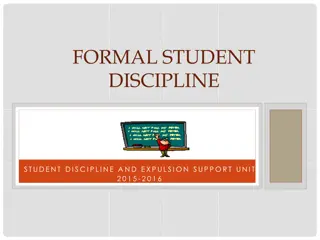Effective Discipline Program and Documentation
An effective discipline program is essential for both employers and employees to address shortcomings and enhance workforce productivity. Proper documentation of disciplinary actions can also safeguard employers during difficult decisions. The program covers principles of disciplinary action, when to take disciplinary action, the progressive disciplinary process, policy implementation, documentation guidelines, and examples.
Download Presentation

Please find below an Image/Link to download the presentation.
The content on the website is provided AS IS for your information and personal use only. It may not be sold, licensed, or shared on other websites without obtaining consent from the author.If you encounter any issues during the download, it is possible that the publisher has removed the file from their server.
You are allowed to download the files provided on this website for personal or commercial use, subject to the condition that they are used lawfully. All files are the property of their respective owners.
The content on the website is provided AS IS for your information and personal use only. It may not be sold, licensed, or shared on other websites without obtaining consent from the author.
E N D
Presentation Transcript
Disciplinary Actions: Issues and Documentation
Introduction An effective discipline program is beneficial to both the employer and employee. It helps employees correct any shortcomings with the goal of becoming a valuable, contributing member of the workforce. Documentation created as a result of the discipline process can also help protect an employer if a termination or other adverse employment decision becomes necessary. 3
Agenda The principles of disciplinary action. When to take disciplinary action. The progressive disciplinary process. Our disciplinary action policy. Documenting disciplinary action. The five Ws of documentation. Sample documentation. 4
The Principles of Disciplinary Action Make sure discipline is the appropriate tool. Consider coaching or performance appraisal as a first step whenever possible. Be honest, frank, fair and precise regarding your reasons for dissatisfaction and your future expectations for the employee. Maintain a professional manner by keeping the disciplinary process confidential between you and the employee and, when necessary, with HR. Keep your criticism free of nonwork-related matters and personal judgement. 5
The Principles of Disciplinary Action (cont.) Provide specific examples of performance discrepancies or work rule violations so the employee fully understands what needs improvement. Allow the employee ample opportunity to respond. Help the employee improve performance by providing specific recommendations and requirements. Communicate clearly so the employee understands the consequences if performance or conduct does not improve. 6
The Principles of Disciplinary Action (cont.) If employees believe they are being treated fairly, they are much more likely to accept the consequences of their actions. Consistent and fair discipline will also help to prevent successful claims of discrimination or other unlawful conduct. Thoroughly investigate the circumstances. Allow the employee an opportunity to respond to the allegation(s). Ensure the "punishment fits the crime" and consequences are applied consistently. Allow for an appeal process to a manager above the rank of the supervisor issuing the discipline and who was not involved in the initial decision. 7
When to Take Disciplinary Action Disciplinary action should be taken when: The employee has recurring issues such as absenteeism or tardiness. The employee has continuing problems following management instructions or company policies despite additional training, coaching or counseling. The employee engages in serious misconduct such as drug or alcohol abuse or workplace safety violations. 8
The Progressive Disciplinary Process Progressive discipline is a method of discipline that uses graduated steps for dealing with problems related to an employee's conduct or performance that do not meet clearly defined standards and policies. The ultimate objective of progressive discipline is to help employees correct conduct problems and resolve performance issues in the earliest stages. 10
The Progressive Disciplinary Process (cont.) There are four steps in our progressive discipline process: 1. Verbal warning. 2. Written reprimand. 3. Final warning or performance improvement plan (may include suspension). 4. Termination. 11
Documenting Disciplinary Actions The following elements should be included in the documentation: The name of the person who is writing the warning, the date, the name of the person receiving the warning and anyone else who gets a copy of it (e.g., HR), and where it is located (e.g., the personnel file). A description of the performance issue or conduct that warranted the warning, with specific examples. A summary of prior discussions regarding the issue, with specific dates if available. A summary of prior related disciplinary or performance issues. An explanation of why the issue is important. 14
Documenting Disciplinary Actions (cont.) The following elements should be included in the documentation (cont.): A description of the policies that were violated. An outline of the employer s expectations. A description of potential consequences for failing to meet those expectations (e.g., a statement that sustained performance improvement is critical and a failure to improve may result in further action, up to and including termination of employment ). A place for signatures acknowledging that the employee received the warning. A notation that the warning will be included in the employee s personnel file. 15
The Five Ws of Documentation Who What Where When Why (only include when the employee gives his or her own explanation) 17
The Five Ws of Documentation (Who) Who: Who was or is involved? What is the person s position within the organization? Who has first-hand knowledge? Are there known or potential witnesses? 18
The Five Ws of Documentation (What) What: Describe the incident or recurring issue. Describe the specific behavior or actions. Use verbs. Do not add your comments, insights or interpretations. 19
The Five Ws of Documentation (Where) Where: Describe the location of the incident. Was it at the workplace or on workplace property? Was it at the client s/customer s workplace or on the workplace property? 20
The Five Ws of Documentation (When) When: Did the incident occur during: Regular work hours? Off-duty time? 21
The Five Ws of Documentation (Why) Why: Do not guess or speculate. Investigate and gather information. Include knowledge or information to support your findings/conclusions. Allow employees to present their version of events/infraction. 22
Summary Follow the principles of discipline including being honest, frank, fair and precise regarding your reasons for dissatisfaction, your future expectations for the employee, and providing the employee with an opportunity to respond. It is important to consider how and when to discipline. Use the five Ws of documentation (who, what, where, when and why) to document disciplinary actions. For additional information on our progressive disciplinary process and documentation, contact human resources. 25
Training Evaluation Please complete the training evaluation sheet included in the handouts. Thank you for your interest and attention! 27























